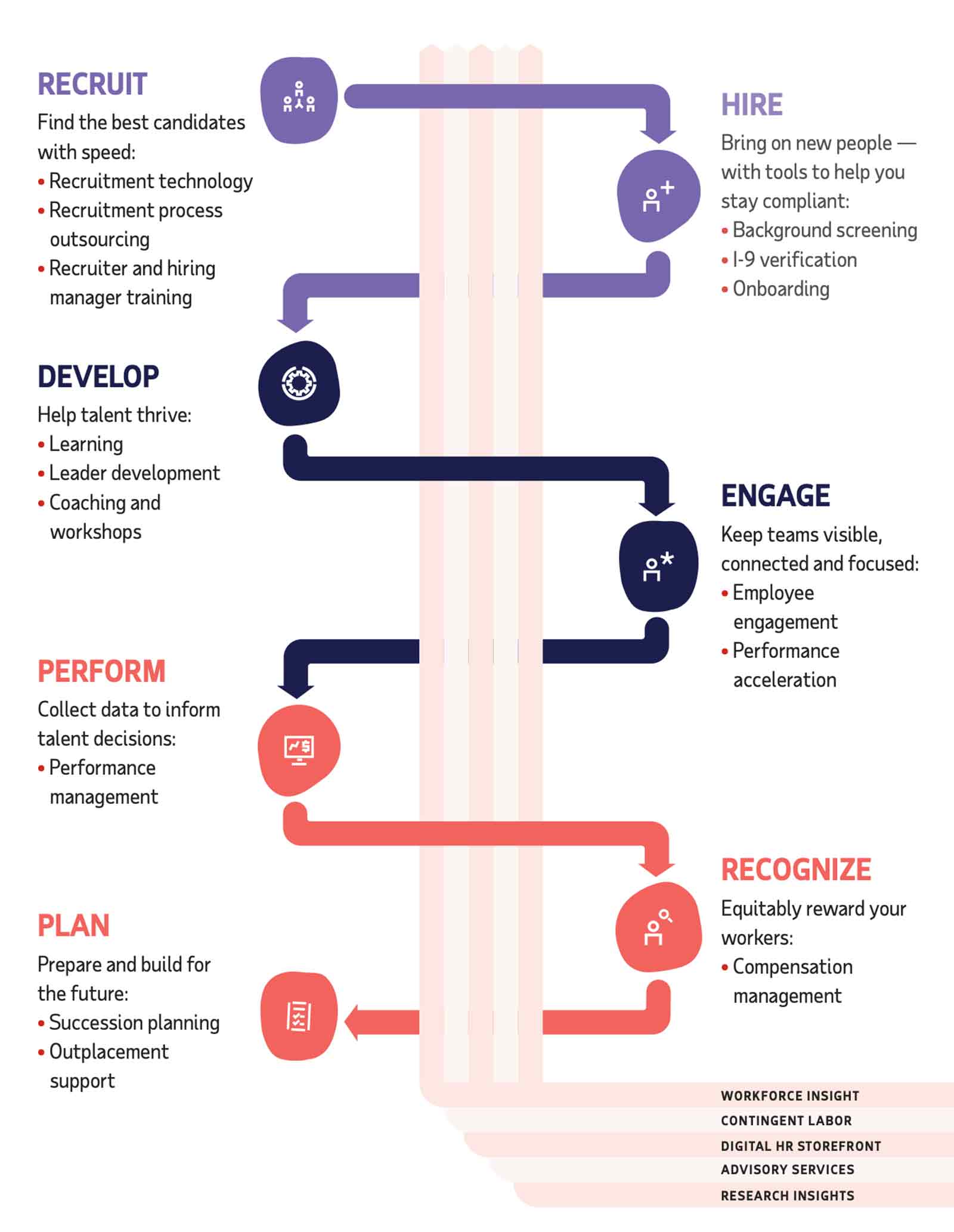Talent management is how employers recruit and develop a workforce that is as productive as possible and likely to stay with their organization long term. When implemented strategically, this process can help improve the overall performance of the business and ensure that it remains competitive.
Table of Contents
What does talent management mean?
Put simply, talent management means investing in an organization’s most important resource – its people. To this end, employers may recruit candidates with highly desirable skillsets, provide ongoing learning and development opportunities, and reward valued team members and encourage them to advance within the organization.
An example of talent management
Real-life examples of talent management happen every day. Consider, for instance, an apparel retailer that wants to transition its business model from simply supplying clothes to delivering customers a truly service-based experience. To achieve this goal, the organization’s leaders know they will need a new breed of associates and managers. They therefore implement assessment and applicant tracking tools to help them hire the right candidates and use real-time performance data to give supervisors the insights they need to make smarter decisions.
Why is talent management important?
Businesses that take the time to develop their employees and keep them engaged tend to be innovative and profitable. Conversely, those that are unable to source or retain talent generally have poor customer satisfaction and limited growth potential.
What are some key components of talent management?
Building the kind of talent strategy that drives an organization forward generally requires employers to:
- Align talent goals with larger business objectives
- Fulfill employee expectations and deliver on hiring promises
- Rely on data to make better workforce decisions
What does talent management include?
Equipping and engaging talent to optimize productivity and fuel growth is not a singular task. There are numerous employer responsibilities, such as the following, which must be fulfilled to excel at talent management:
- Workforce planning
Most talent strategies begin with defining the skillsets that will be required to achieve the business’s objectives. - Recruitment
Acquiring talent consists of representing the employer brand effectively, determining where the right candidates can be reached, prescreening applicants and interviewing promising prospects. - Onboarding
A structured onboarding program that introduces employees to the workplace culture and helps them feel connected to and comfortable with their team and organization is essential to retention. - Training and development
While it was once considered the employee’s responsibility to seek learning opportunities, many workers today expect their employers to provide the tools, guidance, and support they need to further their careers. - Performance management
Reviews and check-ins with team leaders help employees build upon their strengths, thereby increasing engagement and reducing turnover and making it possible for employers to meet key business objectives. - Compensation and benefits
Fair compensation is important, but employers who want to attract and retain talent should take a holistic view of the perks and benefits they offer beyond a paycheck. - Succession planning
Preparing for the next step in the employee journey – whether it’s career advancement, retirement or resignation – can help people transition to new roles quickly and limit disruptions.
Benefits of talent management
When people thrive, businesses thrive. Employers who create a culture that empowers employees to be their best may be able to:
- Recruit in-demand talent
Businesses become employers of choice and attract talent organically by making their brand a central component of their talent strategy. - Minimize disruptions
Unexpected departures cause gaps in coverage, but with a talent pipeline, it’s possible to fill open positions quickly and keep operations running smoothy. - Improve productivity
Continuous strengths-based coaching helps employees develop skills and reach their full potential, thereby increasing efficiency. - Reduce costs
Retaining valued team members and keeping them engaged is usually more cost effective than sourcing and training new hires. - Innovate
Talented teams are more likely to develop new methods of problem solving and make the most of advancements in technology.
What is the talent management process?
The talent management process consists of finding the right people and helping them discover and apply their strengths so they can work and lead more effectively. Employers who do it well generally follow these steps:
- Recruit
Source candidates from outside or within the organization using the most appropriate method, i.e., employee referrals, social networks, job boards, etc. - Hire
Use analysis tools, prescreening questionnaires, skills tests and interviews to narrow the list of candidates and make an offer. - Develop
Make learning and development resources accessible and relevant to employee expectations and needs so they can do their jobs more effectively. - Engage
Keep teams connected and focused with engagement tools that help identify potential retention risks and retain top performers. - Perform
Monitor employee performance and collect data to make more informed workforce decisions. - Recognize
Manage compensation equitably and reward top performers. - Plan
Create succession plans that allow employees to advance their careers when openings become available.
The talent management model
ADP recognizes these pillars of a successful talent strategy:

What is a talent management strategy?
Talent management strategy is a comprehensive plan to attract, onboard, develop, engage and retain a high-performing workforce in ways that align with business objectives. It involves talent acquisition, workforce planning, performance management , learning and development, engagement, and succession planning. Ultimately, the goal is to maximize productivity across the entire employee lifecycle, foster a positive workplace culture and drive organizational success.
How does a talent strategy work?
Organizations today recognize the need for an evolved talent strategy – one that doesn’t just align to business goals, but also drives outcomes. Here are some examples:
- Make workplace culture a top priority
When employees are happy and feel like they belong, they contribute more and stay in their jobs longer. - Provide plenty of growth opportunities
With very few exceptions, employees will leave their jobs unless they have visibility into their career progression options and the right support to pursue them. - Ensure that employees are using their strengths
Understanding what each employee brings to the table and matching individuals to the roles and assignments where they can contribute the most helps improve engagement and efficiency. - Compensate workers fairly
It’s critical for employers to have accurate, real-time benchmarks on compensation data specific to their industry and geographic region if they want to attract and retain in-demand talent. - Hire diverse talent
By providing broader perspectives and new approaches, diversity can improve problem solving and it shows that an organization represents the community it serves.
Talent management planning and best practices
No matter where they are in their talent journey, employers can connect people and work better by following these tips:
- Make decisions based on data
Having reliable, accurate and timely data helps employers deliver on strategic talent initiatives, like pay equity or workforce diversity, with confidence. - Rely on technology
Talent management systems make it easier to source talent, assess skills and qualifications, onboard new hires, manage employee strengths and recognize and reward top performers. - Outsource payroll and HR
With administrative tasks off their plate, business leaders have more time to focus on becoming an employer of choice. Some HR outsourcing providers can also help with recruitment and talent strategy.
Frequently asked questions about talent management
What is another word for talent management?
Other words used to describe talent management are personnel management and HR management, though there are nuances between the three terms.
What's the difference between talent management and talent acquisition?
Talent management deals with engagement and development throughout the employee lifecycle from hire to retire. Talent acquisition is the part of this process that focuses specifically on recruitment.
What is the difference between talent management and HR?
Talent management is commonly a responsibility of HR. It tends to be more strategic than tactical or transactional HR tasks, such as reporting or employee communications.
What is a talent management framework?
A talent management framework is the blueprint for how an organization will execute its talent strategy. It typically includes recruitment, hiring, engagement, development, performance management, recognition, and succession planning.
What is a talent management system?
A talent management system is software that streamlines talent processes. Features vary by provider, but many solutions can help with creating job posts, onboarding new hires, tracking employee performance and more.
What is the most important aspect of talent management?
No talent strategy will succeed unless it delivers what employees really want and need. If an organization’s talent strategy falls flat, it’s an indication of employer-employee disconnect.
This article is intended to be used as a starting point in analyzing talent management and is not a comprehensive resource of requirements. It offers practical information concerning the subject matter and is provided with the understanding that ADP is not rendering legal or tax advice or other professional services.





